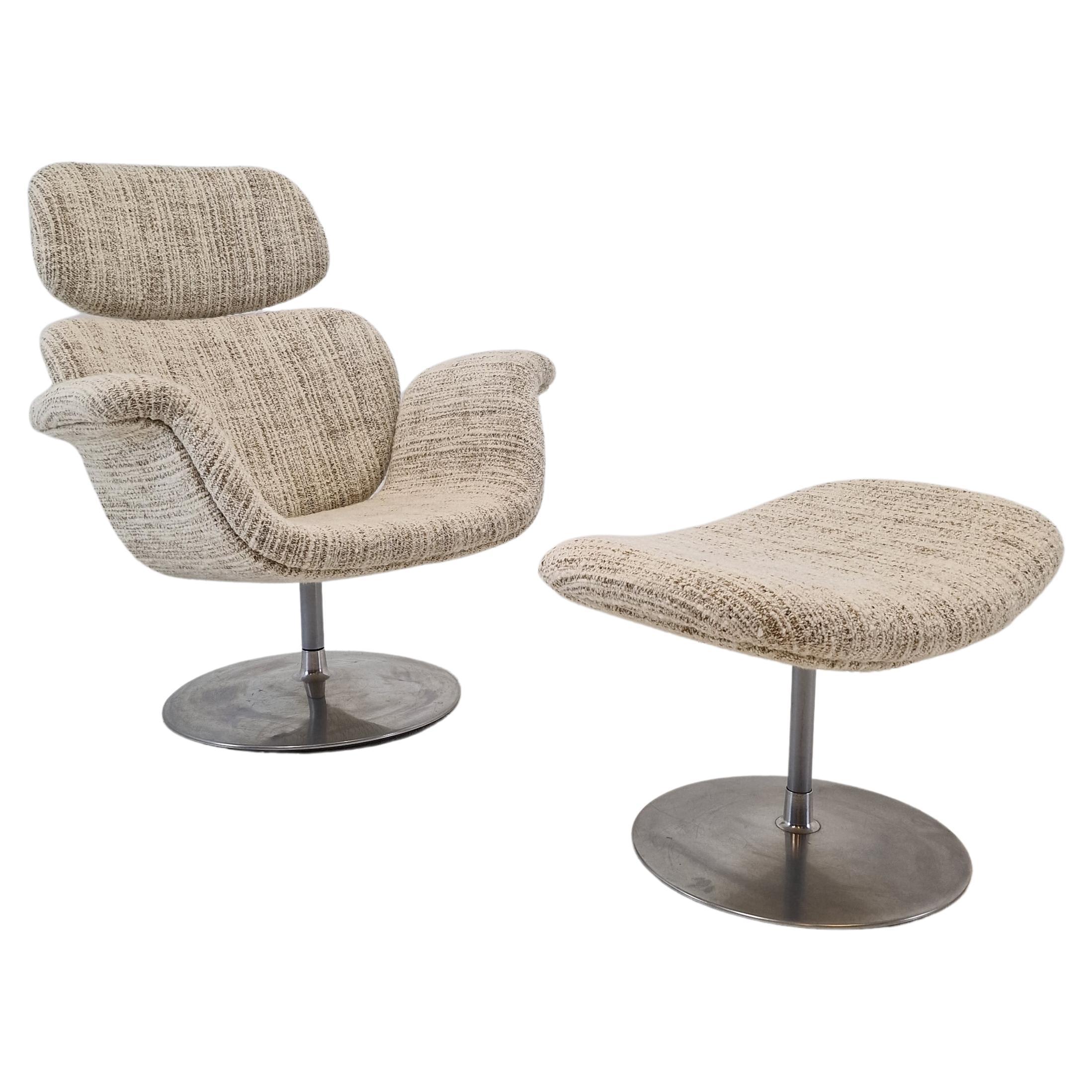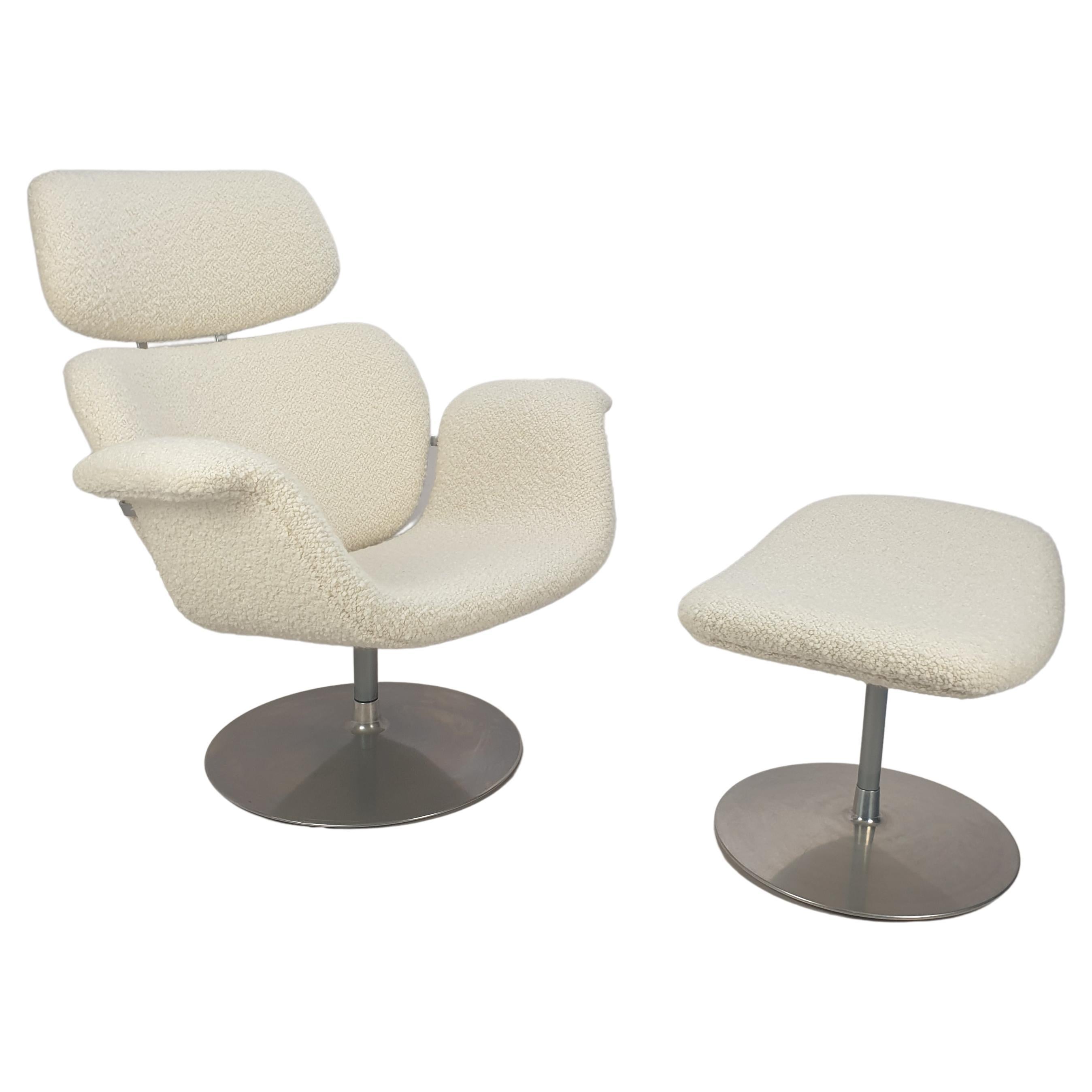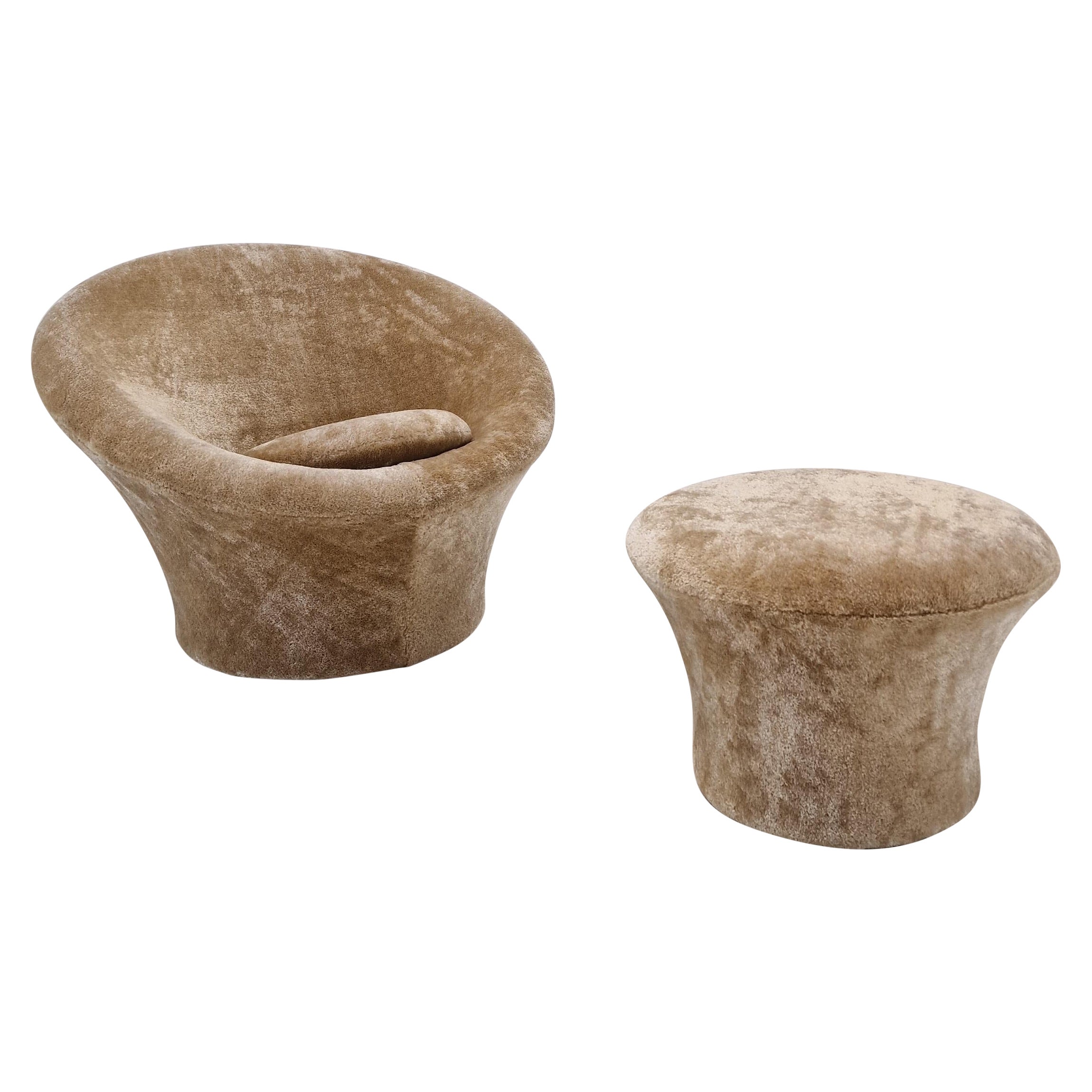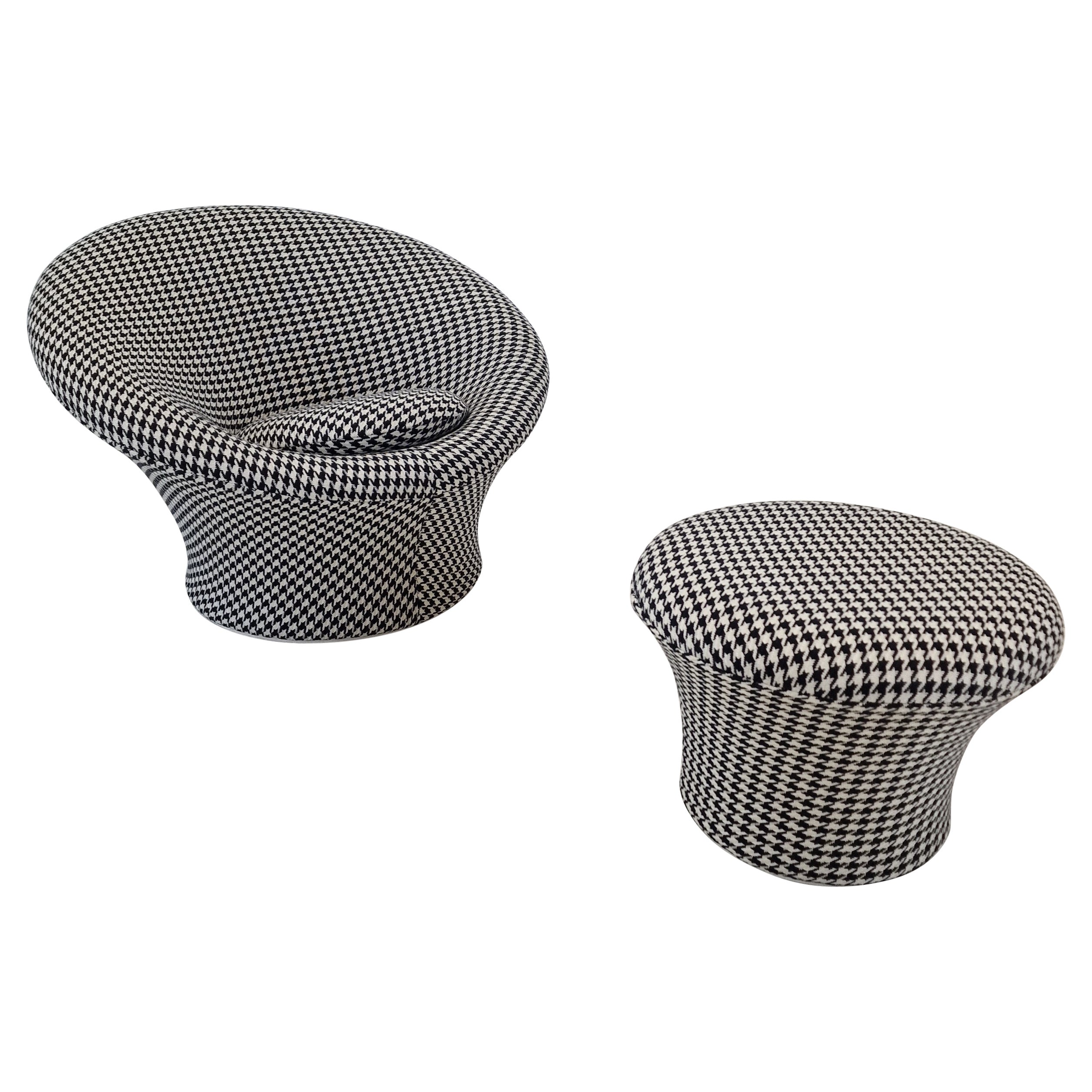Big Tulip Chair and Ottoman by Pierre Paulin for Artifort, 1980s
About the Item
- Creator:Artifort (Manufacturer),Pierre Paulin (Designer)
- Dimensions:Height: 37.01 in (94 cm)Width: 35.04 in (89 cm)Depth: 31.89 in (81 cm)Seat Height: 15.75 in (40 cm)
- Sold As:Set of 2
- Style:Mid-Century Modern (Of the Period)
- Materials and Techniques:
- Place of Origin:
- Period:1980-1989
- Date of Manufacture:1980
- Condition:Reupholstered. The set is completely restored with new fabric and new foam and is in perfect condition. The feet have the normal using spots.
- Seller Location:Oud Beijerland, NL
- Reference Number:1stDibs: LU5578228638972
Pierre Paulin
Pierre Paulin introduced a fresh breeze into French furniture design in the 1960s and ’70s, fostering a sleek new Space-Age aesthetic. Along with Olivier Mourgue, Paulin developed chairs, sofas, dining tables and other furnishings with flowing lines and almost surreal naturalistic forms. And his work became such a byword for chic, forward-looking design and emerging technologies that two French presidents commissioned him to create environments in the Élysée Palace in Paris.
Paulin was born in Paris to a family of artists and designers. He initially sought to become a ceramist and sculptor and was studying in the town of Vallauris near the Côte d'Azur — a center for pottery making, where Pablo Picasso spent his postwar summers crafting ceramics — but broke his hand in a fight. He enrolled at the École Camondo, the Paris interior design school. There, Paulin was strongly influenced by the work of Charles and Ray Eames, George Nelson and Arne Jacobsen, as was reflected in his early creations for the manufacturer Thonet-France.
It was at the Dutch firm Artifort, which he joined in 1958, where Paulin blossomed. In a few years, he produced several of his signature designs based on abstract organic shapes. These include the Butterfly chair (1963), which features a tubular steel frame and slung leather, and a group of striking seating pieces made with steel frames covered in polyurethane foam and tight jersey fabric: the Mushroom (1960), Ribbon (1966) and Tongue (1967) chairs. The revered designer not only introduced new construction techniques to Artifort furniture but contributed fresh materials, Pop art colors and dazzling shapes to the mid-century modern era as a whole.
In 1971, the Mobilier National — a department of France’s Ministry of Culture in charge of furnishing top-tier government offices and embassies — commissioned Paulin to redesign President Georges Pompidou’s private apartment in the Élysée Palace. In three years, Paulin transformed the staid rooms into futuristic environments with curved, fabric-clad walls and furnishings such as bookcases made from an arrangement of smoked-glass U shapes, flower-like pedestal chairs and pumpkin-esque loungers.
Ten years later, the Mobilier National called on Paulin again, this time to furnish the private office of President François Mitterand. Paulin responded with an angular, postmodern take on neoclassical furniture, pieces that looked surprisingly at home in the paneled, Savonnerie-carpeted Louis XVI rooms. As those two Élysée Palace projects show, Paulin furniture works well both in a total decor or when used as a counterpoint to traditional pieces. His creations have a unique personality: bright and playful yet sophisticated and suave.
Find vintage Pierre Paulin lounge chairs, armchairs, coffee tables and other furniture on 1stDibs.
Artifort
The sterling reputation that Artifort enjoys isn’t limited to the innovative upholstery and fluid, organic shapes for which its products are widely known — the legendary Dutch brand’s vintage seating and other furniture is also celebrated for its embodiment of functionality, comfort and quality. These are among the principles that underpin the philosophy toward modern furniture design at Artifort, which has been at the crossroads of furniture and art for over 125 years.
Prior to 1928, the year Artifort officially became a brand, Jules Wagemans had a small upholstery business in Maastricht, the Netherlands. After setting up in 1890, his son, Henricus Wagemans, broadened the scope of the company to include furniture production. By the end of the 1920s, their showroom in Amsterdam had made them a recognizable brand across the Netherlands.
Then named H. Wagemans & Van Tuien, the company changed its name to Artifort after the economic recession. Artifort came from two Latin words meaning “art” and “strong” — a perfect description for the style of each design and the manufacturer’s intention to create sturdy furnishings. Artifort’s reputation for durable armchairs and sofas endures, and vintage editions of this seating are now family heirlooms in many homes.
Artifort became a magnet for high-profile and up-and-coming designers alike. Many furniture designers’ careers began thanks to collaborations with Artifort, such as Dutch industrial and jewelry designer Gijs Bakker and Indonesian-born designer Kho Liang Ie. Also known for designing the interiors at Amsterdam’s Schiphol Airport, Kho Liang Ie was an aesthetic consultant at Artifort and used his expertise to turn the company into a world-class brand. Perhaps his largest contribution, however, was attracting the talents of French furniture and interior designer Pierre Paulin and English furniture designer Geoffrey D. Harcourt.
Paulin’s bright and colorful lounge chairs, such as his Orange Slice chair and Mushroom chair, are still central to the Artifort identity. The revered designer not only introduced new construction techniques to Artifort furniture, but contributed fresh materials, Pop art colors and dazzling shapes to the mid-century modern era as a whole, while Harcourt deserves credit for popularizing Artifort internationally and extending their reach into foreign markets.
Another talent boom in the 1990s at Artifort yielded collaborations with Jasper Morrison, Wolfgang Mezger and René Holten. Iranian designer Khodi Feiz was named art director in 2014 and has continued the tradition of recruiting top designers such as Claesson Koivisto Rune, Ilse Crawford and Luca Nichetto.
Find a collection of vintage Artifort lounge chairs, tables and more on 1stDibs.
- ShippingRetrieving quote...Ships From: Aalsmeer, Netherlands
- Return PolicyA return for this item may be initiated within 14 days of delivery.
- Big Tulip Chair and Ottoman by Pierre Paulin for Artifort, 1980sBy Artifort, Pierre PaulinLocated in Oud Beijerland, NLVery comfortable and original Big Tulip lounge chair with Ottoman, designed by Pierre Paulin for Artifort in 1965. This 80's pivoting edition has a round metal foot. The set ...Category
Vintage 1980s Dutch Mid-Century Modern Armchairs
MaterialsMetal
- Big Tulip Chair and Ottoman by Pierre Paulin for Artifort, 1980sBy Pierre Paulin, ArtifortLocated in Oud Beijerland, NLVery comfortable and original big tulip lounge chair with Ottoman, designed by Pierre Paulin for Artifort in 1965. This 80's pivoting edition has a round metal foot. The set is j...Category
Vintage 1980s Dutch Mid-Century Modern Armchairs
MaterialsMetal
- Big Tulip Chair and Ottoman by Pierre Paulin for Artifort, 1980sBy Pierre Paulin, ArtifortLocated in Oud Beijerland, NLVery comfortable and original big tulip lounge chair with ottoman, designed by Pierre Paulin for Artifort in 1965. This 80's pivoting edition has a round metal foot. The set ...Category
Vintage 1980s Dutch Mid-Century Modern Armchairs
MaterialsMetal
- Mushroom Armchair and Ottoman by Pierre Paulin for Artifort, 1960sBy Pierre Paulin, ArtifortLocated in Oud Beijerland, NLStunning Mushroom set, designed by Pierre Paulin and fabricated by Artifort in the 60s. This very comfortable and cosy set is just covered with beautiful and the highest quality ...Category
Vintage 1960s Dutch Mid-Century Modern Armchairs
MaterialsFabric
- Mushroom Armchair and Ottoman by Pierre Paulin for Artifort, 1960sBy Pierre Paulin, ArtifortLocated in Oud Beijerland, NLStunning Mushroom set, designed by Pierre Paulin and fabricated by Artifort in the 60’s. This very comfortable and cosy set is just covered with beaut...Category
Vintage 1960s Dutch Mid-Century Modern Armchairs
MaterialsFabric
- Mushroom Armchair and Ottoman by Pierre Paulin for Artifort, 1960sBy Artifort, Pierre PaulinLocated in Oud Beijerland, NLStunning Artifort Mushroom set, designed by Pierre Paulin in the 60’s. This very comfortable and cosy set is just covered with beautiful and high qual...Category
Vintage 1960s Dutch Mid-Century Modern Armchairs
MaterialsFabric
- Lounge chair "F545" "BIG TULIP" by Pierre Paulin for Artifort, Netherlands 1980sBy Artifort, Pierre PaulinLocated in DE MEERN, NLSKAI LEATHER LOUNGE CHAIR "F545" BIG TULIP BY PIERRE PAULIN FOR ARTIFORT, NETHERLANDS 1980S Introducing the SKAI Leather Lounge Chair "F545" Big Tulip, a...Category
Vintage 1980s Dutch Mid-Century Modern Lounge Chairs
MaterialsMetal
- Pierre Paulin Ribbon Chair Ottoman by ArtifortBy Artifort, Pierre PaulinLocated in Highland, INThis Pierre Paulin ottoman is waiting to be paired with a ribbon chair to make a set. It retains its original red fabric and silver paint on the base, but both show wear from age and...Category
Vintage 1960s Dutch Mid-Century Modern Ottomans and Poufs
MaterialsUpholstery, Wood
- Orange Slice Chairs by Pierre Paulin for Artifort, 1980s, Set of 2By Artifort, Pierre PaulinLocated in ŁÓDŹ, PLThe famous Artifort orange slice chairs by Pierre Paulin. Designed in the 60s and produced in the 80s. Cute and very comfortable chairs. They have chrome metal legs. This gorgeous...Category
Late 20th Century Dutch Mid-Century Modern Lounge Chairs
MaterialsMetal
- F784 “Concorde” Lounge Chair by Pierre Paulin for Artifort, 1980sBy Artifort, Pierre PaulinLocated in Hilversum, NLPierre Paulin and Artifort developed this ‘Concorde’ lounge chair back in 1960s. The chair has the beautiful original De Ploeg fabric and attract...Category
Vintage 1980s Dutch Mid-Century Modern Lounge Chairs
MaterialsAluminum
- Pierre Paulin for Artifort. “Tulip” armchair. 1980s.Located in Saint-Ouen, FRPierre Paulin for Artifort. “Tulipe” model armchair, swivel and burgundy color. Seat resting on a round chromed metal base. French work realized in the 1980s. Dimensions: H 77 x D...Category
Late 20th Century European Armchairs
MaterialsMetal
- Customizable Artifort Swivel Tulip Lounge with Ottoman by Pierre PaulinBy Artifort, Pierre PaulinLocated in New York, NYThe Tulip armchair for Artifort…. as if designer Pierre Paulin had premonitions of Flower Power! The simple Tulip spreads its half-open petals around the sitter, inviting and warming...Category
21st Century and Contemporary Dutch Modern Armchairs
MaterialsTextile
Recently Viewed
View AllRead More
At Château La Coste, Pierre Paulin’s Visionary Home Concept Finally Comes to Life
Now synonymous with 1960s and ’70s French chic, the designer conceived his modular modernist furnishings to change the way we decorate.
Exploring Our Current Obsession with Sixties Style
A new exhibition in Philadelphia stars a complex decade that continues to inspire.






